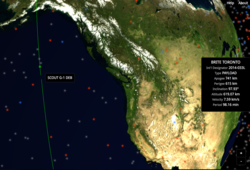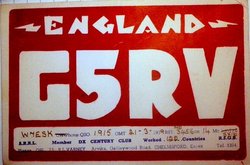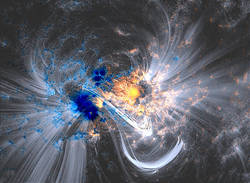 July 14, 2015 Editor: Paul Bourque, N1SFE | |||||
IN THIS ISSUE NEW HF OPERATORS - THINGS TO DO Try RTTY! There's an NCCC RTTY Sprint on (US) Wednesday evening, which is a good warm-up for the NAQP RTTY, which is also coming up. The Contest University PowerPoint Presentation by W0YK Essentials of RTTY Contesting from 2014 is one good place to start, as is AA5AU's Getting Started on RTTY (PDF). If you're going to try RTTY in the Sprint, you'll need The Art of RTTY Sprinting. BULLETINS A new weekly SSB event is starting July 28 (July 29 for you UTC types). The "Phone Fray" rules are based on the North American QSO Party (NAQP). According to Dean, NW2K: "To accommodate busy schedules, the contest lasts for just 30-minutes and will be great for fast-paced NAQP practice and welcoming new contesters of all skill levels. 100 watts max makes everyone loud! No logs, just report scores to 3830scores.com." BUSTED QSOS "You need to include a strong warning with the suggestion for trying Win10 that once Windows 10 is installed YOU CAN'T GO BACK to your original system unless you totally reinstall your original operating system with the original system disks. ... Win8.1 has been great and I am looking forward to Win10."(Carl, K0TNT) CONTEST SUMMARY Complete information for all contests follows the Conversation section July 16 July 17 July 18
July 19 July 20 July 22 July 23 July 24 July 25 July 26 July 29 The RBN is being used for scientific research into Space Weather. The investigator mined historic RBN data to see if there was a correlation between reduced propagation reports and solar events. A new class of metallic materials which appears to act as a conductor and an insulator simultaneously has been described by scientists at the University of Cambridge. Samarium hexaboride is an insulator at low temperatures. However when the researchers examined a sample while it was subject to a magnetic field, they observed free mobility of electronics more indicative of a conductor. Though this compound has been studied for decades, it's still too soon to tell what this latest observation could mean. The original article appeared in Quanta Magazine. (Dennis N6KI)
If you'd like to see the magnitude and particulars of intended and unintended objects orbiting our home planet, try http://stuffin.space/. Be aware that it will give your browser a workout and performs better on faster computers. Lockheed Martin broke ground on the new S-band 'space fence' back in May, with a stated capability of detecting softball sized objects in earth orbit. Contest robots? No, a robot contest challenge. Each robot weighs over 9000 pounds and is piloted by humans. "Cascadia Rising 2016" is a year-long earthquake preparedness exercise culminating in a four day simulation of a subduction zone earthquake's effect on the Pacific Northwest in June 2016. This exercise puts the potential of a quake like this in context, relating it to recent and historical seismic events in Asia and other locations. Certainly there would be an Amateur Radio component of the disaster response, with impacts far beyond the immediately devastated area. VHF repeaters in the affected areas would likely be either inoperative or unable to communicate with distant regional coordination centers, and communications traffic would likely be passed via HF voice and digital modes. If you're interested in participating in the four days in June, and located primarily in the states of Oregon, Washington and the Province of British Columbia you should contact your local ARRL ARES EC or RAC EC or Mike Chaplin, mhchaplin43@hotmail.com NC7Q. Outside of the PNW, contact either Mike or your county based ARES Emergency Coordinator.
Web Site of the Week - Nasa.gov's New Horizons Mission The big news this week for NASA is the Pluto flyby by the New Horizons spacecraft. After leaving Earth in early 2006, it has reached its destination and is returning closer photos of Pluto than we've ever had before. One has to continue to admire the planning and engineering that goes into long term missions like these. How are the communications for the spacecraft done? Check out this paper. WORD TO THE WISE Grazing Incidence - Radio waves hitting a layer of the ionosphere at very small angles with respect to the layer, which are then reflected, are referred to as "grazing incidence." Picture a rock skipping across a lake - the smaller the angle between the path of the rock and the surface of the lake, the more likely a skip. See the Article referenced in Technical Topics for more information as it relates to 6 meters!
Danny, K7SS sends along the G5RV QSL from 1939. W7ESK, Rush Drake, later went on to use the call W7RM. Danny writes "Rush was born 1918... First big MM on the west coast..won the CQWW for the country a few times in the 1970s... first and only time, that a west coast station has won." At the time of the Q, W7ESK was 21 years old. Later on he'd go on to own a famous QTH on Foul Weather Bluff overlooking Puget Sound, and become a member of the CQ Contest Hall of Fame.
"NU1AW from 7 land is not your pappy's NU1AW running from the east coast." - Dink, N7WA's lament in his 3830 score report.
A sneak peek: The scores database and log checking reports for the 2015 ARRL RTTY Roundup are available on the ARRL web site. "In the ARRL VHF Contest, the K5QE team claimed 130 grids on 2m, which if confirmed may be a new record." (Terry W8ZN) OPERATING TIP If a 'dupe' calls you while you're running, work them and continue. There are very few, perhaps zero, contests which will penalize you for logging duplicate contacts. Do not explain to your caller that you've worked before. It generally takes more time than just working them again. However, if they've called you three times before in the same contest, you don't have to answer their fourth call. Respond to someone else. The only exception to consider may be contests with long exchanges, like Sweepstakes.
Though primarily targeted towards explaining how F2 Propagation on 50MHz works, this article by K6MIO on 50 MHz F2 Propagation provides a good explanation of atmospheric ionization, and choice other tidbits, such as that >50% of the mass of the earth's atmosphere is concentrated in the lower 6km... The RBN (Reverse Beacon Network) gets continued notice as a means to do solar science: http://www.earthmagazine.org/article/amateur-radio-users-help-scientists-study-space-weather/. The RBN was also mentioned for this use in a previous issue of this newsletter. The HobbyPCB RS-UV3 is a tri-band VHF/UHF building block providing an FM Transceiver on 144/220/450 MHz. It plugs directly into an Arduino as a shield, but can also be used with other 3.3/5.0v serial capable computers like Raspberry Pi and Beaglebone. It claims on-board support for beacon, repeater, single channel voice, Echolink, APRS and Packet. If you generate any type of information in electronic form such as station documentation, source code, logger macros, configuration information, and the like, you should be familiar with version control, and using it for your electronic files. Some of the benefits of doing so include being able to have a log of document changes over time, being able to easily roll back changes when they don't quite work as planned, and about a hundred other reasons. Many of the programs that provide version control (e.g. mercurial, git, etc.) are free. Here's a nice introduction about why you should be using version control. If you're using a computer to generate your RTTY signals, you might not be aware that the timing of our transmitted characters could be affected by everything else your computer has to do at the same time (e.g. logging, anti-virus, spot processing, etc.). There's a great guest column by Larry, K8UT about bit jitter in NCJ July/August 2015's "RTTY Contesting" column, and how it can be eliminated by hardware generation of RTTY characters. Here's a link to Ed W0YK's previous comments on eliminating Jitter from the RTTY contesting reflector. The reason why you should be aware of this issue is that stations receiving a jittery signal may not be able to decode it effectively, and they'll ask for repeats. Or, if you're calling CQ, listeners may not be able to decode your call. If you are doing SDR work, and need to go faster than audio speeds, you're probably using FPGAs. If you're using FPGAs you have to target a particular vendor's chips with a particular tool chain - the low-level programming information (bitstream format) isn't available. Here's an article on how a team reverse engineered the bitstream of a Lattice Semiconductor iCE40 part, making it possible to use open source tools to program it. In a related vein, here's a small form factor open source design for a miniPCIe FPGA development board, using a Xilinx part. Lithium cells have been wonderful to power our higher-power portable Ham gear, however there have been incidents of some cells self-destructing when damaged or defective. One failure mode is attributed to the formation of dendrites between the anode and cathode of the cell, effectively shorting it. Stanford researchers have found that adding a two-chemical combination to cell chemistry can potentially reduce 'spiky' dendrite formation. Their potential solution (also applicable to other battery chemistries) is still a few generations away from commercial production. Some hams bemoan the use of surface mount electronics in modern gear. But how about ICs? Taken to an extreme, it would be possible to build a CPU using non-integrated circuits... and someone has done (most of) it. No estimate on when a mobile version of this 16 bit processor will be available, but it could involve 18 wheels. Technical Web Site of the Week - rtl-sdr.com Perhaps you've heard of the DVB-Dongle, one of which is also known RTL-SDR dongle - it's a low cost (less than $20) SDR receiver in the form factor of a USB key, originally intended for DVB-T reception with a computer. They can be repurposed for general purpose SDR usage. This site provides a representative set of articles featuring the RTL-SDR, including setting up CW-Skimmer with RTL-SDR and HDSDR. The Good Old Days As is inevitable when hams gather and chat about all the important things that we need to chat about, there's nostalgia for the 'good old days.' That period for many seems to be the "honeymoon period" of about the time they received their license, to some other time between then and now. It's rare that I hear 'today' being included in the good old days. It's great to have the wonderful memories of our Elmers, the thrill of working our first contacts, our first rigs, but it's not taking away from any of those recollections to also appreciate and take advantage of the Amateur Radio landscape of today. From my Amateur Radio Contesting viewpoint, today we have transceivers that have never been better at taking the smallest perturbations in the ether, and turning it into audio. The materials that we are able to employ for our stations can literally be products of the space age. We can get almost any part or material to our doorstep in a few short days if necessary. We can have the experience of 1927 on 160 meters using CW, and then also recover signals we can't even hear reflected from the surface of the moon. With the same gear. When we submit our scores to the 'crowdsourced' score reporting sites (e.g. 3830scores.com), we can likely know the 'unofficial results' of a contest in just a few days. Through the continuing efforts of organizations like the ARRL, Contest University, WWROF, regional radio and contest clubs, and many others, today's Elmers are being immortalized on the Internet through webinars, videos, and presentations in various formats. We'll have their wisdom to enjoy for a long, long time. Contest sponsors are evolving to strongly preserve and protect the integrity of the varied entry classes, so that the 'boy and his radio' (and 'girl and her radio') and the SOnR(A) entrants are scored only against their peers. The interval between contest end and contest results is growing ever shorter. The variety and frequency of radio contests continue to increase. There are challenges, to be sure, including some that we've been facing for a while, such as an aging population, issues of continued recruitment into the hobby, and the public perception of relevance in the face of other communications technologies. But on balance, it's great to be a ham in 2015! An expanded, downloadable version of QST's Contest Corral in PDF format is available. Check the sponsor's Web site for information on operating time restrictions and other instructions. HF CONTESTS CWops Mini-CWT Test, Jul 15, 1300z to Jul 15, 1400z, Jul 15, 1900z to Jul 15, 2000z, Jul 16, 0300z to Jul 16, 0400z; CW; Bands: 160, 80, 40, 20, 15, 10m; Member: Name + Member No., non-Member: Name + (state/province/country); Logs due: July 18.
QRP Fox Hunt, Jul 17, 0100z to Jul 17, 0230z; CW; Bands: 20m Only; RST + (state/province/country) + name + power output; Logs due: July 18. NCCC RTTY Sprint, Jul 17, 0145z to Jul 17, 0215z; RTTY; Bands: (see rules); Serial No. + Name + QTH; Logs due: July 19. NCCC Sprint, Jul 17, 0230z to Jul 17, 0300z; (see rules); Bands: (see rules); Serial No. + Name + QTH; Logs due: July 19. Trans-Tasman Low-Bands Challenge, Jul 18, 0800z to Jul 18, 1400z; CW, Phone, Digital; Bands: 160, 80, 40m; RS(T) + Serial No.; Logs due: July 25.
Feld Hell Sprint, Jul 18, 1600z to Jul 18, 1759z; Feld Hell; Bands: 160, 80, 40, 20, 15, 10, 6m; (see rules); Logs due: July 25. North American QSO Party, RTTY, Jul 18, 1800z to Jul 19, 0559z; RTTY; Bands: 80, 40, 20, 15, 10m; NA: Name + (state/province/country), non-NA: Name; Logs due: July 26. RSGB Low Power Contest, Jul 19, 0900z to Jul 19, 1200z, Jul 19, 1300z to Jul 19, 1600z; CW; Bands: 80, 40m; RST + Serial No. + Power; Logs due: July 27. Run for the Bacon QRP Contest, Jul 20, 0100z to Jul 20, 0300z; CW; Bands: 160, 80, 40, 20, 15, 10m; RST + (state/province/country) + (Member No./power); Logs due: July 26. SKCC Sprint, Jul 22, 0000z to Jul 22, 0200z; CW; Bands: 160, 80, 40, 20, 15, 10m; RST + (state/province/country) + Name + (SKCC No./power); Logs due: July 24. CWops Mini-CWT Test, Jul 22, 1300z to Jul 22, 1400z, Jul 22, 1900z to Jul 22, 2000z, Jul 23, 0300z to Jul 23, 0400z; CW; Bands: 160, 80, 40, 20, 15, 10m; Member: Name + Member No., non-Member: Name + (state/province/country); Logs due: July 18. RSGB 80m Club Championship, Data, Jul 23, 1900z to Jul 23, 2030z; RTTY, PSK; Bands: 80m Only; RST + Serial No.; Logs due: July 30. QRP Fox Hunt, Jul 24, 0100z to Jul 24, 0230z; CW; Bands: 20m Only; RST + (state/province/country) + name + power output; Logs due: July 18. NCCC RTTY Sprint, Jul 24, 0145z to Jul 24, 0215z; RTTY; Bands: (see rules); Serial No. + Name + QTH; Logs due: July 19. NCCC Sprint, Jul 24, 0230z to Jul 24, 0300z; (see rules); Bands: (see rules); Serial No. + Name + QTH; Logs due: July 19. RSGB IOTA Contest, Jul 25, 1200z to Jul 26, 1200z; CW, SSB; Bands: 80, 40, 20, 15, 10m; RS(T) + Serial No. + IOTA No.(if applicable); Logs due: August 16. County Hunters CW Contest, Jul 25, 1400z to Jul 26, 0000z, Jul 26, 1400z to Jul 27, 0000z; CW; Bands: 80, 40, 20, 15, 10m; RST + (state+county/"DX"); Logs due: August 31. ARS Flight of the Bumblebees, Jul 26, 1700z to Jul 26, 2100z; CW; Bands: 40, 20, 15, 10m; Home: RST + (state/province/country) + Power, Bumblebee: RST + (state/province/country) + Bumblebee no.; Logs due: August 9. CWops Mini-CWT Test, Jul 29, 1300z to Jul 29, 1400z, Jul 29, 1900z to Jul 29, 2000z, Jul 30, 0300z to Jul 30, 0400z; CW; Bands: 160, 80, 40, 20, 15, 10m; Member: Name + Member No., non-Member: Name + (state/province/country); Logs due: July 18. Phone Fray, July 29, 0230Z to July 29 0300Z; SSB; Bands: 160, 80, 40, 20, 15; Op name and QTH (S/P/C) for NA stations. Op name only for non-NA stations; Logs due: 48 hours after contest end. VHF+ CONTESTS CQ Worldwide VHF Contest, Jul 18, 1800z to Jul 19, 2100z; Any mode (see rules); Bands: 6, 2m; 4-character grid square; Logs due: August 2. LOG DUE DATES July 15, 2015 July 16, 2015 July 18, 2015 July 19, 2015 July 20, 2015 July 21, 2015 July 22, 2015 July 26, 2015 July 28, 2015 ARRL Information Click here to advertise in this newsletter, space subject to availability. Your One-Stop Resource for Amateur Radio News and Information ARRL membership includes QST, Amateur Radio's most popular and informative journal, delivered to your mailbox each month. Subscribe to NCJ - the National Contest Journal. Published bimonthly, features articles by top contesters, letters, hints, statistics, scores, NA Sprint and QSO Parties. Subscribe to QEX - A Forum for Communications Experimenters. Published bimonthly, features technical articles, construction projects, columns and other items of interest to radio amateurs and communications professionals. Free of charge to ARRL members: Subscribe to The ARRL Letter (weekly digest of news and information), the ARES E-Letter (monthly public service and emergency communications news), Division and Section news -- and much more! ARRL offers a wide array of products to enhance your enjoyment of Amateur Radio. Visit the site often for new publications, specials and sales. Donate to the fund of your choice -- support programs not funded by member dues! Reprint permission can be obtained by sending email to permission@arrl.org with a description of the material and the reprint publication. ACKNOWLEDGEMENTS ARRL Contest Update wishes to acknowledge information from WA7BNM's Contest Calendar and SM3CER's Contest Calendar. | |||||










